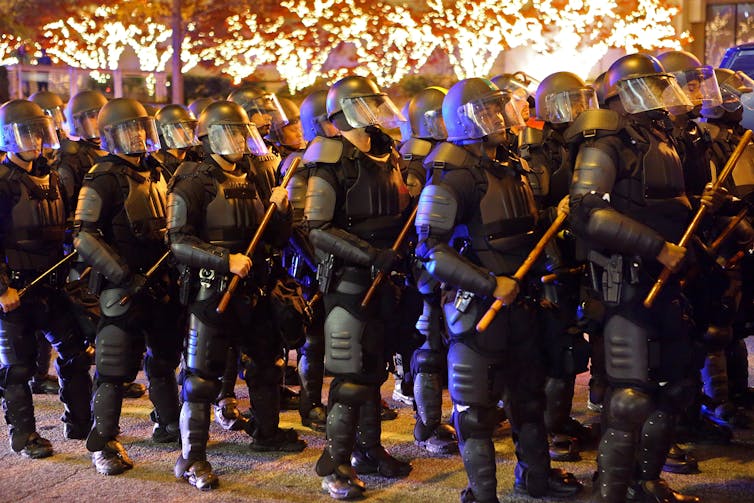Rise in temperatures and humidity linked to forest loss has reduced safe hours for working in the tropics

Labourers (SCAFFOLDERS) at a construction site in Jakarta, Indonesia.
Photograph: Mast Irham/EPA
Sofia Quaglia
Fri 17 Dec 2021
Deforestation has made outdoor work unsafe for millions of people in the tropics over the past 15 years, a study has found.
The rise in temperatures and humidity caused by tree loss has reduced the number of safe hours in the day for people to work, especially for those performing heavy labour.
“Because of climate change, these areas in the tropics are already on the edge of what’s considered safe or comfortable for working in the late morning to afternoon,” said Luke Parsons, a climate researcher at Duke University in North Carolina and lead author of the paper published in the journal One Earth. “And then you take deforestation on top of that and it pushes these regions over into even more unsafe work conditions.”
A growing body of research has shown that deforestation is linked to an increase in local temperatures, as it decreases the cooling benefits trees bring to an area. For example, in the areas of the Amazon in Brazil which have been heavily deforested, over the past two decades the temperatures have been as much as 10C higher than forested regions.
For this study, the researchers parsed satellite and meteorological data between 2003 and 2018 in 94 countries with tropical forests, looking at temperature and humidity.
They found that almost 100,000 people, 90% of whom live in Asia, have lost more than two hours of work time a day. Almost 5 million people have lost at least half an hour of safe work time each day, the majority of them outdoor workers doing heavy physical labour.
The effects are disproportionately felt in deforested locations; in the Americas, 5% of forested areas lost at least half an hour of safe work time a day, while 35% of deforested areas suffered the same loss.
“We couldn’t go to every single location where people are working and measure when they stopped working,” said Parsons. “We can make this assessment of lost safe work time, but people may often in fact choose to continue to work when it is too hot and humid, at the detriment to their health.”
Continued global heating and forest loss is expected to amplify these impacts, reducing work hours for vulnerable groups even more over coming decades.
Exposure to heat could affect mood and mental illnesses, as well as reduce physical and psychological performance, including lapses in concentration, fatigue, irritability, increasing the risk of accidents, said Beatriz Oliveira, researcher at the Sergio Arouca National School of Public Health in Brazil, who was not involved in this study.
The researchers say their findings provide an economic incentive for local populations to maintain intact local forests on top of the environmental benefits.
Sofia Quaglia
Fri 17 Dec 2021
Deforestation has made outdoor work unsafe for millions of people in the tropics over the past 15 years, a study has found.
The rise in temperatures and humidity caused by tree loss has reduced the number of safe hours in the day for people to work, especially for those performing heavy labour.
“Because of climate change, these areas in the tropics are already on the edge of what’s considered safe or comfortable for working in the late morning to afternoon,” said Luke Parsons, a climate researcher at Duke University in North Carolina and lead author of the paper published in the journal One Earth. “And then you take deforestation on top of that and it pushes these regions over into even more unsafe work conditions.”
A growing body of research has shown that deforestation is linked to an increase in local temperatures, as it decreases the cooling benefits trees bring to an area. For example, in the areas of the Amazon in Brazil which have been heavily deforested, over the past two decades the temperatures have been as much as 10C higher than forested regions.
For this study, the researchers parsed satellite and meteorological data between 2003 and 2018 in 94 countries with tropical forests, looking at temperature and humidity.
They found that almost 100,000 people, 90% of whom live in Asia, have lost more than two hours of work time a day. Almost 5 million people have lost at least half an hour of safe work time each day, the majority of them outdoor workers doing heavy physical labour.
The effects are disproportionately felt in deforested locations; in the Americas, 5% of forested areas lost at least half an hour of safe work time a day, while 35% of deforested areas suffered the same loss.
“We couldn’t go to every single location where people are working and measure when they stopped working,” said Parsons. “We can make this assessment of lost safe work time, but people may often in fact choose to continue to work when it is too hot and humid, at the detriment to their health.”
Continued global heating and forest loss is expected to amplify these impacts, reducing work hours for vulnerable groups even more over coming decades.
Exposure to heat could affect mood and mental illnesses, as well as reduce physical and psychological performance, including lapses in concentration, fatigue, irritability, increasing the risk of accidents, said Beatriz Oliveira, researcher at the Sergio Arouca National School of Public Health in Brazil, who was not involved in this study.
The researchers say their findings provide an economic incentive for local populations to maintain intact local forests on top of the environmental benefits.
















